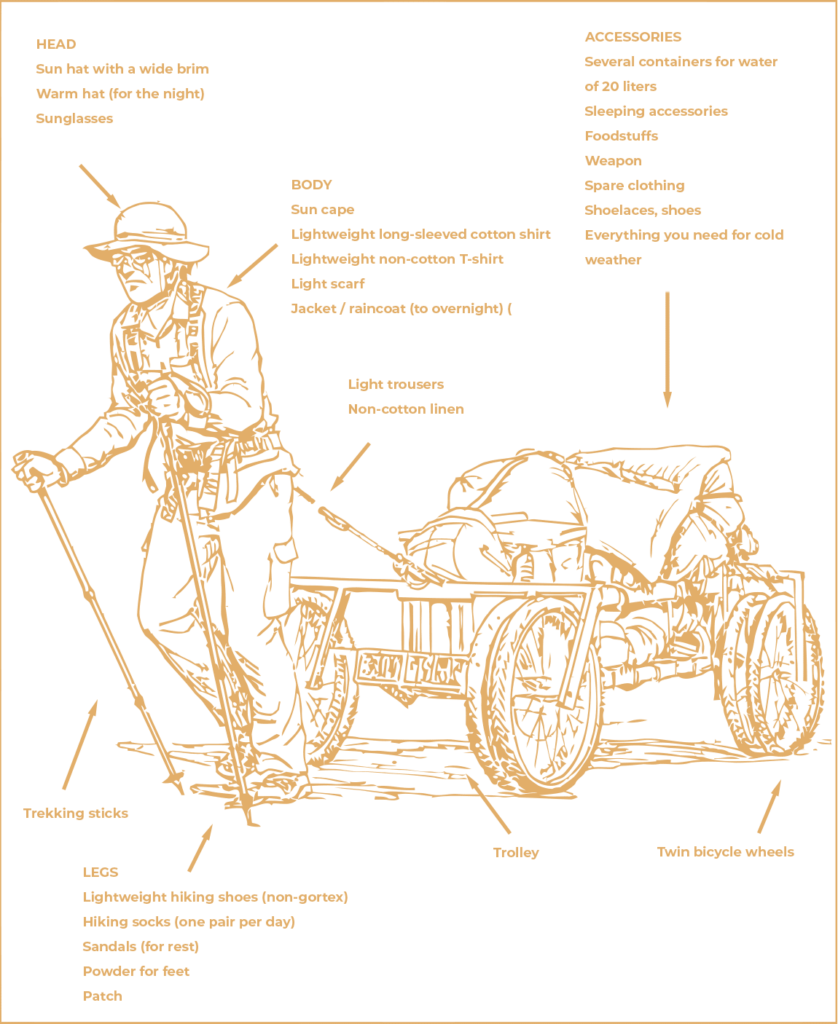DESERT KIT
Traveling in a desert area requires carrying a large amount of water, at the rate of about 4 liters per day, plus a reserve in case of an unforeseen situation. However, a liter of water weighs quite a lot, and if you carry a load weighing more than 6 kg, then later you will lose more liquid than you can replace with water taken with you. In addition, you need to carry cold weather equipment, which is indispensable for the large temperature extremes typical of deserts. Remember that every item has a weight. But if you are going to tow the load, the energy costs will be only 20% and therefore it is important to have a device that allows you to drag the load behind you.
For these purposes, an expeditionary wheeled cart of the simplest design is ideal, which you can either buy or make yourself from PVC pipes and bicycle wheels. It is better to install two wheels, as shown in the picture below, as it is possible to puncture a tire very quickly on a hot surface dotted with sharp stones. The second wheel will allow you not to stop at a puncture and not waste energy on changing the tire.
Orientation
Make transitions at night and sleep during the day. This will make it easier for you to cope with extreme temperature changes in the desert. When the sun goes down, the heat drops very quickly and temperatures can drop by 30 degrees. Re-attuning the body to stay awake at night will save on water and energy. You will not have to waste a lot of fluids moving around in the heat, and your body will not expend precious kilocalories to keep warm during sleep on a cold night.
It is difficult to navigate on a fairly flat area, without any peculiarities, even during the day. During night-time transitions, you will see worse in the dark, but you will have a useful navigation asset – many bright stars in the sky. For a short course in astronavigation read the article on orienteering. At night in the desert it is not at all as dark as you think, but after sunset, the perception of space deteriorates. Use trekking poles to facilitate movement in these conditions.
When it comes to orientation, it is always safer to assume that one or more of your tools might not work. It is important to have reserve variants. In addition, prepare a very detailed route map before setting off on your journey. The better you get to know the area before starting your trip, the better prepared you will be for possible emergencies. If there are no visible landmarks, always count the steps. This will help you at least approximately track the distance traveled in any given direction. Count every second step.
For an adult, the stride length is approximately one meter, and therefore, when counting hundreds of double steps, it can be assumed that about 200 m has been passed.
Use every opportunity to restock. If clouds appear in the sky or it rains, try to climb to a higher area of the terrain: in the desert, torrential streams can occur very quickly. Replenish your water supply with every rainfall.
Equipment and clothing
The right footwear is of the utmost importance. Trekking boots, specially designed for high temperatures, avoid irritation to the feet, which can lead to painful blisters that interfere with walking. Take patches from wet callus, foot powder, and plenty of replacement socks on your trip. In desert conditions, cotton socks can cause a dangerous disease – a trench foot. Lightweight wool socks will help keep your feet dry and prevent tissue necrosis.

For clothing, cotton fabric may well work. Although manufacturers of synthetic fabrics claim that their products already surpass natural fibers in terms of cooling and moisture management, under the scorching sun no other material can replace breathable cotton. Synthetics, especially when it comes to soft, frictionless synthetic underwear, are good if they are not exposed to direct sunlight. A lightweight scarf is needed to protect the neck and face from wind and sunburn, as well as during sandstorms. If you have any doubts about clothing, take a look at how the local people dress.
Remember, preparing for extreme temperature changes in the desert means you won’t be traveling light.
Stock up on clothing for cold weather: use it when making transitions at night. The proverb “A light bag is, of course, easier to carry, but at night you will freeze” is true not only for arctic conditions, but also for the desert.






